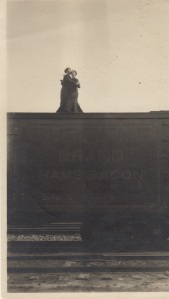Of the very many teachers I have had in my long life, one sticks out in memory: Miss Adams, my kindergarten teacher. Her kindergarten class was quite famous, and rightly so
She had, in the first place, lots of energy, and in the second place, what she did with it was to give herself two rooms, a sitting-down classroom and a block room. In the block room sat piles of commissioned blocks made out of two-by-fours. So they were big blocky blocks, they weren’t these little chintzy things with letters.
That’s what made me think about the culture of the period. I remember that we used to have a record, or maybe it was a whole album, called “Building a City”,[Hindemith’s “Wir Bauen Eine Stadt” ?] and it’s all physical construction: “We’re building a city, We’re building a city, digging and pounding, we’re working all together.” It was Popular Front Socialism. The workers of the period were physical workers. I’m thinking of the politics of early childhood then, which were intense, really. You wanted the kids to attach to physical construction. For ages they had been trying to get kids out of the dirt, and to sit down a practice their penmanship; that was the big Victorian period kids’ activity. Here there was the reverse. You didn’t want the kids fiddling around making nice curves, you wanted them building, building. And then I was thinking about what got lost out of that. It wasn’t just penmanship; it was politics, and money, and banking, the less physical parts of the whole process, which we have come to realize (to our sorrow), are quite important, and that was willfully kept out of it.
I don’t know what Miss Adams thought about it. Maybe she would have been creative enough to think of something to do about it, but she wanted the kids to look at the city as a physical thing. I think in those days, and always, there’s a big thing about taking kids out to see the Firemen. They adore the fire truck, and the firemen, who generally have very little to do, are quite pleased to show off the fire truck, so a trip to the firehouse has been a standard for ages, but Miss Adams’ walks included all sorts of other stuff, but nothing politicky or banky. They were things like stores and loading docks and stuff like that, but she did like to take the kids around the city.
It was also the state of mind. Rather than stressing the excitement of the fire truck, (which has got its problems for young kids, because you want them to love the firemen because they are the quintessential first responders, but on the other hand you don’t want them obsessing away about fires). What they did was to take the kids out (and these were very young kids} in a gaggle, to look at the city, and then (and I don’t know if she realized how clever this was) the kids took the blocks and built, in blocks, a replica of what they’d seen, so that she was also teaching them how you abstract and represent something in another medium.
It was the University of Chicago Lab School, and that’s relevant too. It was thought of as a laboratory for practicing practical thought. It was founded by John Dewey, a major American philosopher, and the quintessential American philosopher, because he had this pragmatic, this useful information thing. The Laboratory School was, maybe not his creation, but something that he commanded. He had some idea that it would lead to practical intelligence. How you would do it, I doubt if he had much of a clue, but Miss Adams was the perfect person for the job. I don’t know if Dewey picked Miss Adams, or if they were just at the same point in history, but they were on the same wavelength. I came to understand that she really was a genius. What it really takes in early childhood education (besides resources, and it helps a lot to have twenty kids in the room instead of forty, and stuff like that) you need a decisive idea. Miss Adams had a strong and correct idea, and a thought of how to put it to work.
I’m trying to think of why it left such an impression. One reason was, it was a good idea. It was a good idea partly because it gave the kids something that they could do but it was also a good idea because it was powered by an ideal, an ideal which was the popular leftism of the period. Without that, the blocks by themselves wouldn’t have stuck in my head so much. I think that I understood that I was a part of something moral.

